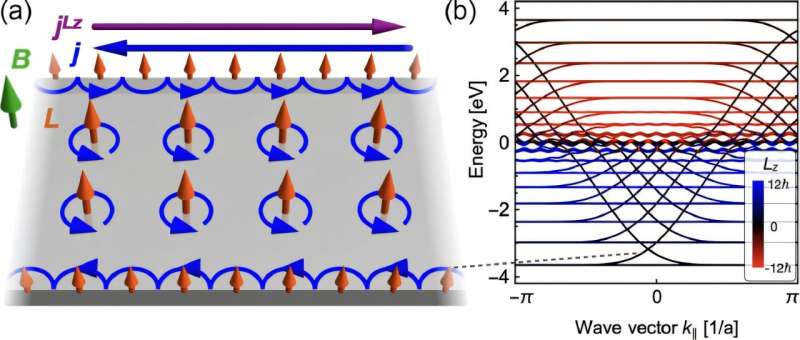
December 17, 2024 by Tom Leonhardt, Martin Luther University Halle-Wittenberg
Collected at: https://phys.org/news/2024-12-current-generated-quantum-hall-effect.html
The quantum Hall effect, a fundamental effect in quantum mechanics, not only generates an electric but also a magnetic current. It arises from the motion of electrons on an orbit around the nuclei of atoms. This has been demonstrated by the calculations of a team from Martin Luther University Halle-Wittenberg (MLU), which are now published in the journal Physical Review Letters. These results can potentially be used to develop new types of inexpensive and energy-efficient devices.
Electricity flows through all types of electronic devices, be it mobile phones or computers. However, this generates heat, which means that energy is lost. It also means that conventional computer chips cannot be infinitely scaled down. In the field of spin-orbitronics, researchers are looking for alternatives for storing and processing information without the loss of energy.
The basic idea is to utilize not only an electron’s charge, but also its spin and orbital moment when processing information. Spin is the intrinsic angular momentum of an electron, and the orbital moment arises from the motion of the electrons around atomic nuclei. “Combining both effects would allow us to design new devices that are more powerful and efficient,” says physicist Professor Ingrid Mertig at MLU.
The basis for the new study is the quantum Hall effect. Klaus von Klitzing received the Nobel Prize in Physics in 1985 for its detection. The effect is observed when electrons are subjected to a very strong magnetic field at extremely low temperatures.
“The quantum Hall effect is special because the electric currents that are generated only flow at the edges of a sample. Furthermore, the associated electrical resistance can only take on specific values,” explains Dr. Börge Göbel.
Even though scientists have been aware of the effect for several decades, the team’s calculations have provided a new insight: The edge currents also have magnetic properties due to the orbital moment of the electrons.
“In the future, they could be used to transport additional information and to operate electrical devices more efficiently,” says Göbel. Remarkably, the new effect occurs in addition to the quantum Hall effect and is not tied to rare and expensive materials, as is often the case in spintronics.
Göbel and Mertig are already continuing their research as part of the international research project “Orbital Engineering for Innovative Electronics” (Obelix). The goal is to find new, marketable technologies. To this end, Mertig and Göbel are collaborating with research institutions in Germany, France and Sweden. Mertig and Göbel are also contributing their expertise in the field of spin-orbitronics by participating in the planned “Center for Chiral Electronics.”
More information: Börge Göbel et al, Orbital Hall Effect Accompanying Quantum Hall Effect: Landau Levels Cause Orbital Polarized Edge Currents, Physical Review Letters (2024). DOI: 10.1103/PhysRevLett.133.146301
Journal information: Physical Review Letters

Leave a Reply